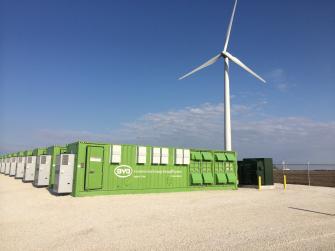Energy storage market booms, with more growth to come
The market has its challenges, but nothing seems to stand in the way of its explosive growth.

Falling costs and new deployment incentives are fueling record investments in energy storage. Depending on the application, costs have declined 74 percent since 2013 [PDF] and are projected to continue a steady 8 percent per year decline through the mid 2020s.
Over the next two decades, these investments are projected to soar by $620 billion. China, the United States and seven other nations will lead the race — and between 2017 and 2022, projections suggest that the market will grow nine times in size.
Employment is booming, too. From 2015 to 2016, energy storage jobs increased 235 percent to reach 90,800 jobs. By 2022, deployments are projected to increase an eye-popping 859 percent.
What's driving this explosive growth?
With firms such as Tesla, GE and Lockheed Martin leading the sector, hundreds of millions of dollars of capital is flowing toward research, development and commercialization, lowering costs.
In fact, the cost has come down so fast that today, many utilities are moving toward renewable energy — coupled with energy storage — rather than building costly new natural gas power plants.
The largest price drop in utility-scale lithium-ion storage systems occurred between 2014 and 2015, plummeting 29 percent. The following year saw a 26 percent price decline, and last year, 12 percent. As hardware costs fall, the utility-scale system price is expected to continue its decline, dropping 36 percent by 2022.
Market incentives further fuel adoption
The biggest driver of growth going forward — outside of cost — is likely to be the development of new market opportunities and value streams opened up by favorable federal and state regulations.
For example, the New York Public Service Commission recently authorized a $310 million market acceleration bridge incentive and set a statewide energy storage target of 3,000 megawatts by 2030. Additionally, some analysis has suggested that actions taken by the Federal Energy Regulatory Commission will unlock another 7,000 to 50,000 megawatts nationwide.
Such incentives and targets can close market gaps and help reduce regulatory barriers to further develop market growth, as shown in California, Massachusetts and Oregon.
National policy also plays a role. In 2016, the White House issued over 30 executive actions and private-sector commitments to accelerate the grid integration of renewable energy and storage. This could lead to at least 1.3 gigawatts of additional energy storage procurement through 2021 and $1 billion more in investments.
Not all energy storage is clean. Here's why
Key challenges to overcome
All this success may come with a price: How and when energy storage is used determines whether it reduces emissions or actually creates more. Also, current market rules don’t compensate energy storage providers for a majority of the services they can provide.
Further market incentives can address both of these issues, with investors and developers of storage technology playing a key role in steering the conversation with policymakers.
Expert commentary
MEDIA CONTACT
Erica Fick
(213) 435-7160 (office)










